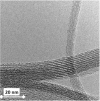Single-walled carbon nanotubes loaded hydroxyapatite-alginate beads with enhanced mechanical properties and sustained drug release ability
- PMID: 32002771
- PMCID: PMC7289977
- DOI: 10.1007/s40204-020-00127-2
Single-walled carbon nanotubes loaded hydroxyapatite-alginate beads with enhanced mechanical properties and sustained drug release ability
Abstract
Single-walled carbon nanotubes (SWCNTs) containing biomaterial with enhanced mechanical properties for the potential orthopedic application were synthesized and investigated. X-ray diffraction and X-ray fluorescence analysis were indications of the formation of calcium-deficient (Ca/P = 1.65) hydroxyapatite (HA) with a small carbonate content under influence of microwave irradiation. The investigated mechanical properties (maximal relative deformation, compressive strength and Young's modulus) of SWCNT loaded HA-alginate composites confirm their dependence on SWCNTs content. The compressive strength of HA-alginate-SWCNT and the HA-alginate control (202 and 159 MPa, respectively) lies within the values characteristic for the cortical bone. The addition of 0.5% SWCNT, in relation to the content of HA, increases the Young's modulus of the HA-alginate-SWCNT (645 MPa) compared to the SWCNT-free HA-alginate sample (563 MPa), and enhances the material shape stability in simulated physiological conditions. Structural modeling of HA-alginate-SWCNT system showed, that physical adsorption of SWCNT into HA-alginate occurs by forming triple complexes stabilized by solvophobic/van der Waals interactions and H-bonds. The high-performance liquid chromatography demonstrated the influence of SWCNTs on the sustained anaesthesinum drug (used as a model drug) release (456 h against 408 h for SWCNT-free sample). Cell culture assay confirmed biocompatibility and stimulation of osteoblast proliferation of 0.05% and 0.5% SWCNT-containing composites during a 3-day cultivation. All these facts may suggest the potential possibility of using the SWCNT-containing materials, based on HA and alginate, for bone tissue engineering.
Keywords: Alginate; Drug release; Hydroxyapatite; Mechanical properties; Single-walled carbon nanotubes.
Conflict of interest statement
The authors declare that they have no conflict of interest.
Figures









References
-
- Andón FT, Fadeel B. Programmed cell death: molecular mechanisms and implications for safety assessment of nanomaterials. Acc Chem Res. 2013;46:733–742. - PubMed
-
- Beladi F, Saber-Samandari S. Cellular compatibility of nanocomposite scaffolds based on hydroxyapatite entrapped in cellulose network for bone repair. Mater Sci Eng C. 2017;75:385–392. - PubMed
-
- Beyer M, Reichert J, Heurich E, Jandt KD, Sigusch BW. Pectin, alginate and gum arabic polymers reduce citric acid erosion effects on human enamel. Dent Mater J. 2010;26:831–839. - PubMed
-
- Boontheekul T, Kong HJ, Mooney DJ. Controlling alginate gel degradation utilizing partial oxidation and bimodal molecular weight distribution. Biomaterials. 2005;26:2455–2465. - PubMed
-
- Buchelnikov AS, Voronin DP, Kostjukov VV, Deryabina TA, Khrapatiy SV, Prylutskyy YuI, Ritter U, Evstigneev MP. Complexation of aromatic drugs with single-walled carbon nanotubes. J Nanopart Res. 2014;16:2472.
LinkOut - more resources
Full Text Sources
Miscellaneous

